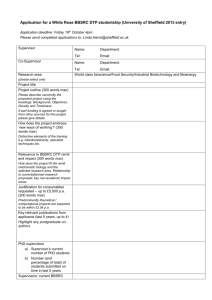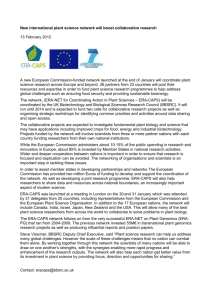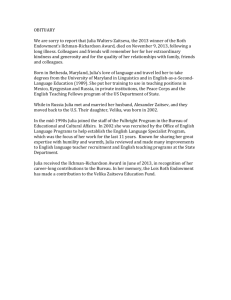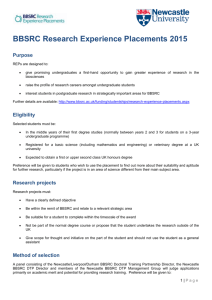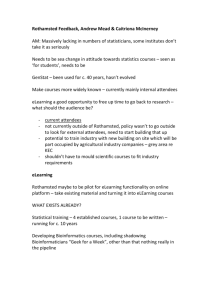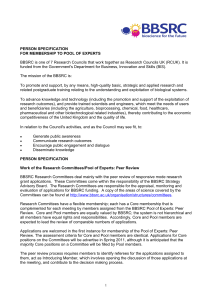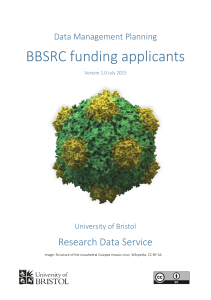Her own research investigates the role of water in protein structure
advertisement
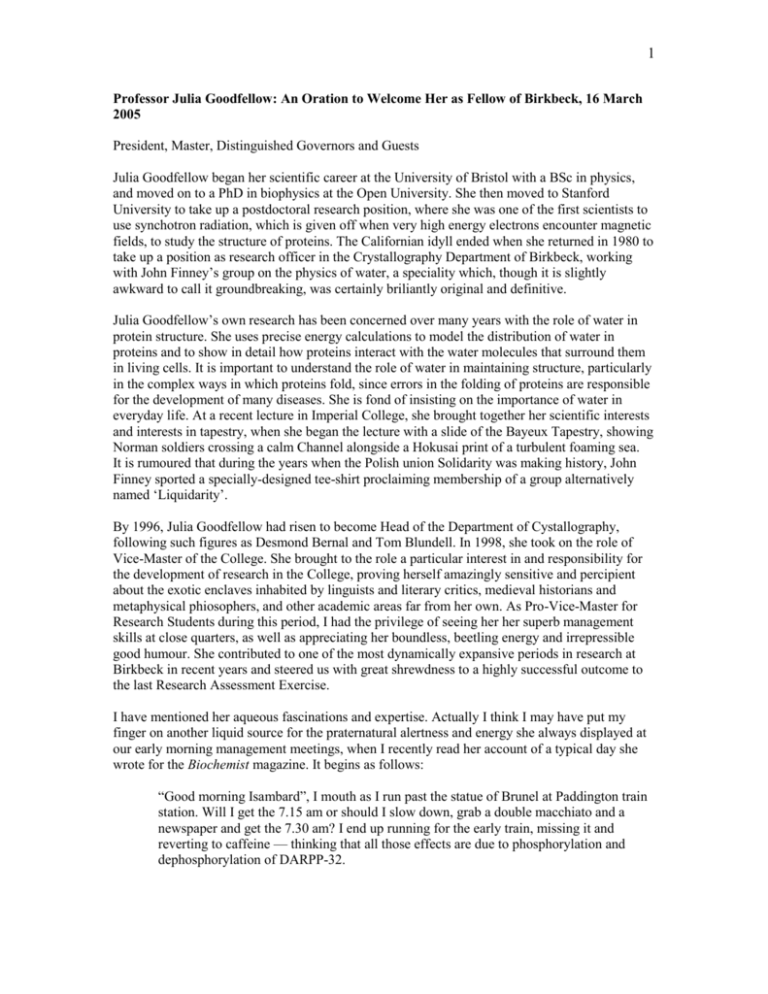
1 Professor Julia Goodfellow: An Oration to Welcome Her as Fellow of Birkbeck, 16 March 2005 President, Master, Distinguished Governors and Guests Julia Goodfellow began her scientific career at the University of Bristol with a BSc in physics, and moved on to a PhD in biophysics at the Open University. She then moved to Stanford University to take up a postdoctoral research position, where she was one of the first scientists to use synchotron radiation, which is given off when very high energy electrons encounter magnetic fields, to study the structure of proteins. The Californian idyll ended when she returned in 1980 to take up a position as research officer in the Crystallography Department of Birkbeck, working with John Finney’s group on the physics of water, a speciality which, though it is slightly awkward to call it groundbreaking, was certainly briliantly original and definitive. Julia Goodfellow’s own research has been concerned over many years with the role of water in protein structure. She uses precise energy calculations to model the distribution of water in proteins and to show in detail how proteins interact with the water molecules that surround them in living cells. It is important to understand the role of water in maintaining structure, particularly in the complex ways in which proteins fold, since errors in the folding of proteins are responsible for the development of many diseases. She is fond of insisting on the importance of water in everyday life. At a recent lecture in Imperial College, she brought together her scientific interests and interests in tapestry, when she began the lecture with a slide of the Bayeux Tapestry, showing Norman soldiers crossing a calm Channel alongside a Hokusai print of a turbulent foaming sea. It is rumoured that during the years when the Polish union Solidarity was making history, John Finney sported a specially-designed tee-shirt proclaiming membership of a group alternatively named ‘Liquidarity’. By 1996, Julia Goodfellow had risen to become Head of the Department of Cystallography, following such figures as Desmond Bernal and Tom Blundell. In 1998, she took on the role of Vice-Master of the College. She brought to the role a particular interest in and responsibility for the development of research in the College, proving herself amazingly sensitive and percipient about the exotic enclaves inhabited by linguists and literary critics, medieval historians and metaphysical phiosophers, and other academic areas far from her own. As Pro-Vice-Master for Research Students during this period, I had the privilege of seeing her her superb management skills at close quarters, as well as appreciating her boundless, beetling energy and irrepressible good humour. She contributed to one of the most dynamically expansive periods in research at Birkbeck in recent years and steered us with great shrewdness to a highly successful outcome to the last Research Assessment Exercise. I have mentioned her aqueous fascinations and expertise. Actually I think I may have put my finger on another liquid source for the praternatural alertness and energy she always displayed at our early morning management meetings, when I recently read her account of a typical day she wrote for the Biochemist magazine. It begins as follows: “Good morning Isambard”, I mouth as I run past the statue of Brunel at Paddington train station. Will I get the 7.15 am or should I slow down, grab a double macchiato and a newspaper and get the 7.30 am? I end up running for the early train, missing it and reverting to caffeine — thinking that all those effects are due to phosphorylation and dephosphorylation of DARPP-32. 2 He team of expert researchers I employ to assist me in preparing these orations inform me that dephosphorylation is also the process that causes the leaves of the plant Mimosa pudica to droop when touched and phosphorylation the process that makes some people more susceptible than others to the effects of alcohol. In any case, it seems we all owe a debt to DARPP-32, for the fact that neither droop nor, as far as I know, inebriation were ever in evidence during the period of Julia Goodfellow’s Vice-Mastership.. When she left us to replace Ray Baker as head of the Biotechnology and Biological Sciences Research Council (the BBSRC) in August 2001, she was, and remains, the first female head of any of the UK’s Research Councils. Indeed she retains this lamentable distinction, being the only female Goodfellow among the literally good fellows who head up the other Research Councils. Predictably and agreeably, a great deal was made of this, although equally predictably, Julia emphasised in interviews her sense of how natural it should be for a woman to be appointed to such a role. It was not as though she had no experience in the high-level management of science, for she had served on the councils both of the BBSRC and the Council for the Central Laboratories of the Research Councils, and had been a member of EPSRC's life science college, and BBSRC's Audit and Remuneration Committees. At the same time, her position has given her a platform to publicise the conditions of female involvement in science and, in particular the ‘leaky pipe’ effect, a metaphor which seems to have replaced the glass ceiling, which leads so many women to drop out of scientific careers along the way,. She has spoken of how supportive she found her colleagues at Birkbeck, having herself been appointed to a lectureship here when she was 8½ months pregnant, but takes a keen interest in the working conditions and prospects of girls and women elsewhere in education and science. She sees the BBSRC as having a key role in communicating enthusiasm about the biological sciences to young people, and especially young women. The BBSRC is responsible for supporting all aspects of the biosciences and biotechnology including many in which the UK is internationally competitive or a world leader, for example plant science; post-genomics; biology of stem cells and nuclear transfer; animal health; and structural biology. It has an annual budget of around £300 million, with which it funds research in universities and eight other sponsored institutes and supports a number of important industrial stakeholders including the agriculture, food, chemical, healthcare and pharmaceutical sectors.. It supports 2000 university researchers, 3200 institute staff and 2000 postgraduate students. The areas of scientific enquiry supported by the BBSRC are among the most dynamic and important in the contemporary world. Julia Goodfellow has pointed out how strong and internationally competititve is the UK research base in biotechnology and the life sciences, but has also taken the opportunity to warn that, given the giddying rate of progress in these areas, it is necessary for British bioscience to press forward vigorously over the next few years. Among the research projects the BBSRC is currently supporting is research is animal locomotion by the Royal Veterinary College, including what it is that makes racehorses fast. In January this year, we heard of research at the Rothamstead Research Institute that explained why it is that some people get bitten by mosquitoes more than others (research that involved volunteers being encased in foil sleeping bags so that their distinguishing odours could be collected. Meanwhile, continuing the olfactory theme, researchers at Imperial College London supported by the BBSRC have now discovered that the airflow through the nose that helps you to experience smells is actually more complicated than the airflow over a jumbo jet’s wing. The BBSRC has recently announced the sequencing of the chicken genome, in which scientists at the BBSRC-sponsored Roslin Institute and the Institute for Animal Health in Compton, Berkshire played a large part. 3 May 2004 saw the opening of the world’s first Stem Cell Bank, established and supported jointly by the Medical Research Council and the BBSRC. Stem-cell research holds the promise of treatments for devastating conditions such as Parkinson's, stroke, Alzheimer's and even cancer. As Julia Goodfellow observed at the opening of the Bank, “Stem cell therapy will remain a dream unless we can understand and control the processes that switch these cells into specialised types such as brain or pancreas cells. The Bank will help us to achieve this by providing isolated and well-characterised cells for research.”. One the most exciting and significant documents to have emanated from the BBSRC under her leadership is a report entitled Bioscience in Society which sets out a ten-year vision for the biological sciences. It looks to a world in which biological research will be at the centre of a complex network of collaborations and shared resources. Julia Goodfellow is like many in the field of biology in that her own background has not been specifically as a biologist. But this is a feature of the field, so much so that Julia has herself suggested that the definition of a biologist might usefully be changed from somebody with biological training, to anybody working on a biological problem, whether they be a mathematician, engineer, or chemist. This brings with it a further challenge to which the BBSRC has been responding, namely how to bring these many different areas and styles of work together to form a single multidimensional picture of the workings of living organisms. Last year, the BBSRC announced plans to establish three Centres for Integrative Biology, which are intended to integrate disciplines such as biology, chemistry, computer science, engineering and mathematics in world-class research. It is perhaps not surprising that somebody who spends so much time thinking about how to weave together such different areas should identify as one of her pursuits tapestry-making, which she took up when he family refused to accept any more of the outcomes of her bouts of manic knitting. (The effects of DARPP-32 again, no doubt.) The BBSRC’s ten-year vision also foresees a world in which the massive increase in biological data will enable so-called ‘dry’ biological research (which is to say, digital and in silico modelling) to supplement ‘wet’ research, based upon observation and experiment with living organisms. This, combined with the greater 'integrative' or holistic understanding of the biological sciences may enable the emergence of a new era of predictive biology, which will enable scientists mathemaically to model biological systems and processes, from biochemical pathways, cells, tissues and organs to whole organisms and populations. This should lead to the development of more efficient and ecologically friendly agricultural processes. Modelling the processes whereby cells and tissues work ought also to make it possible to design more effective and safer pharmaceuticals, and to reduce the reliance on animal testing. Julia Goodfellow was awarded a CBE for services to biophysics in the Queen’s Birthday Honours list in 2001. She is a fellow of the Academy of Medical Sciences, the Institute of Biology and the Royal College of Arts. In a couple of months, she will go to Durham to receive an honorary Doctor of Science from the University of Durham. At the end of last year her appointment was announced as Science Trustee on the board of the National Endowment for Science, Technology and the Arts. Among the unique awards NESTA administers are the Dreamtime fellowships, which allow figures established in one discipline to explore connections and possibilities in some other area of thought or practice. I have had the pleasure of sitting next to her on this platform many times, as she has enthusiastically applauded the achievements of graduates in all subjects across the college. Of course, her surname foredoomed her one day to occupy the alarmingly exposed chair she is currently occupying and to endure the jokes I have been wringing from it this morning (the name, that is, not the chair) I am deeply proud to have been her colleague; and so it is not only a great, 4 but also a very personal pleasure and privilege to welcome Julia Goodfellow, scientist, weaver of worlds, leader of men and women, and nurse of futures - not to mention caffeineophile and fellow Arsenal supporter - as Fellow of Birkbeck College.
